Legal Solutions for Resolving Disputes: Advice and Support
VerifiedAdded on 2020/11/13
|7
|2162
|3703
Report
AI Summary
This report provides a comprehensive overview of legal solutions for dispute resolution, exploring various methods such as negotiation, mediation, conciliation, expert determination, adjudication, and arbitration. It examines the effectiveness of these solutions, the sources of legal advice and support, and the impact of legal aid and taxation on businesses. The report also delves into organizational structures, comparing and contrasting different approaches and evaluating the effectiveness of legal solutions and support services. It emphasizes the importance of empowering businesses with legal knowledge and setting targets for efficient legal work. Furthermore, it discusses the role of legal assistance services and strategies in resolving legal problems and measuring their effectiveness through outcomes.
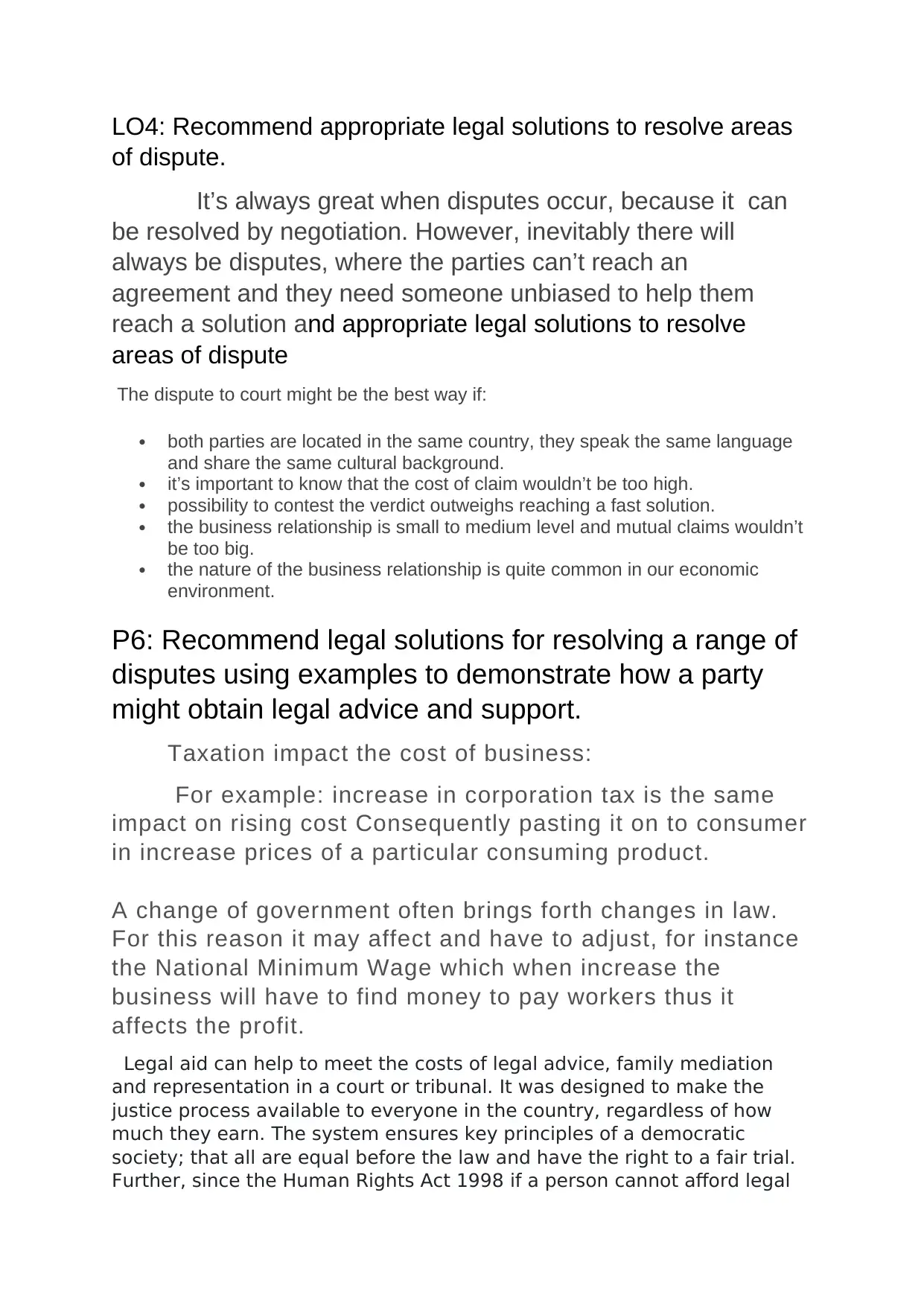
LO4: Recommend appropriate legal solutions to resolve areas
of dispute.
It’s always great when disputes occur, because it can
be resolved by negotiation. However, inevitably there will
always be disputes, where the parties can’t reach an
agreement and they need someone unbiased to help them
reach a solution and appropriate legal solutions to resolve
areas of dispute
The dispute to court might be the best way if:
both parties are located in the same country, they speak the same language
and share the same cultural background.
it’s important to know that the cost of claim wouldn’t be too high.
possibility to contest the verdict outweighs reaching a fast solution.
the business relationship is small to medium level and mutual claims wouldn’t
be too big.
the nature of the business relationship is quite common in our economic
environment.
P6: Recommend legal solutions for resolving a range of
disputes using examples to demonstrate how a party
might obtain legal advice and support.
Taxation impact the cost of business:
For example: increase in corporation tax is the same
impact on rising cost Consequently pasting it on to consumer
in increase prices of a particular consuming product.
A change of government often brings forth changes in law.
For this reason it may affect and have to adjust, for instance
the National Minimum Wage which when increase the
business will have to find money to pay workers thus it
affects the profit.
Legal aid can help to meet the costs of legal advice, family mediation
and representation in a court or tribunal. It was designed to make the
justice process available to everyone in the country, regardless of how
much they earn. The system ensures key principles of a democratic
society; that all are equal before the law and have the right to a fair trial.
Further, since the Human Rights Act 1998 if a person cannot afford legal
of dispute.
It’s always great when disputes occur, because it can
be resolved by negotiation. However, inevitably there will
always be disputes, where the parties can’t reach an
agreement and they need someone unbiased to help them
reach a solution and appropriate legal solutions to resolve
areas of dispute
The dispute to court might be the best way if:
both parties are located in the same country, they speak the same language
and share the same cultural background.
it’s important to know that the cost of claim wouldn’t be too high.
possibility to contest the verdict outweighs reaching a fast solution.
the business relationship is small to medium level and mutual claims wouldn’t
be too big.
the nature of the business relationship is quite common in our economic
environment.
P6: Recommend legal solutions for resolving a range of
disputes using examples to demonstrate how a party
might obtain legal advice and support.
Taxation impact the cost of business:
For example: increase in corporation tax is the same
impact on rising cost Consequently pasting it on to consumer
in increase prices of a particular consuming product.
A change of government often brings forth changes in law.
For this reason it may affect and have to adjust, for instance
the National Minimum Wage which when increase the
business will have to find money to pay workers thus it
affects the profit.
Legal aid can help to meet the costs of legal advice, family mediation
and representation in a court or tribunal. It was designed to make the
justice process available to everyone in the country, regardless of how
much they earn. The system ensures key principles of a democratic
society; that all are equal before the law and have the right to a fair trial.
Further, since the Human Rights Act 1998 if a person cannot afford legal
Paraphrase This Document
Need a fresh take? Get an instant paraphrase of this document with our AI Paraphraser
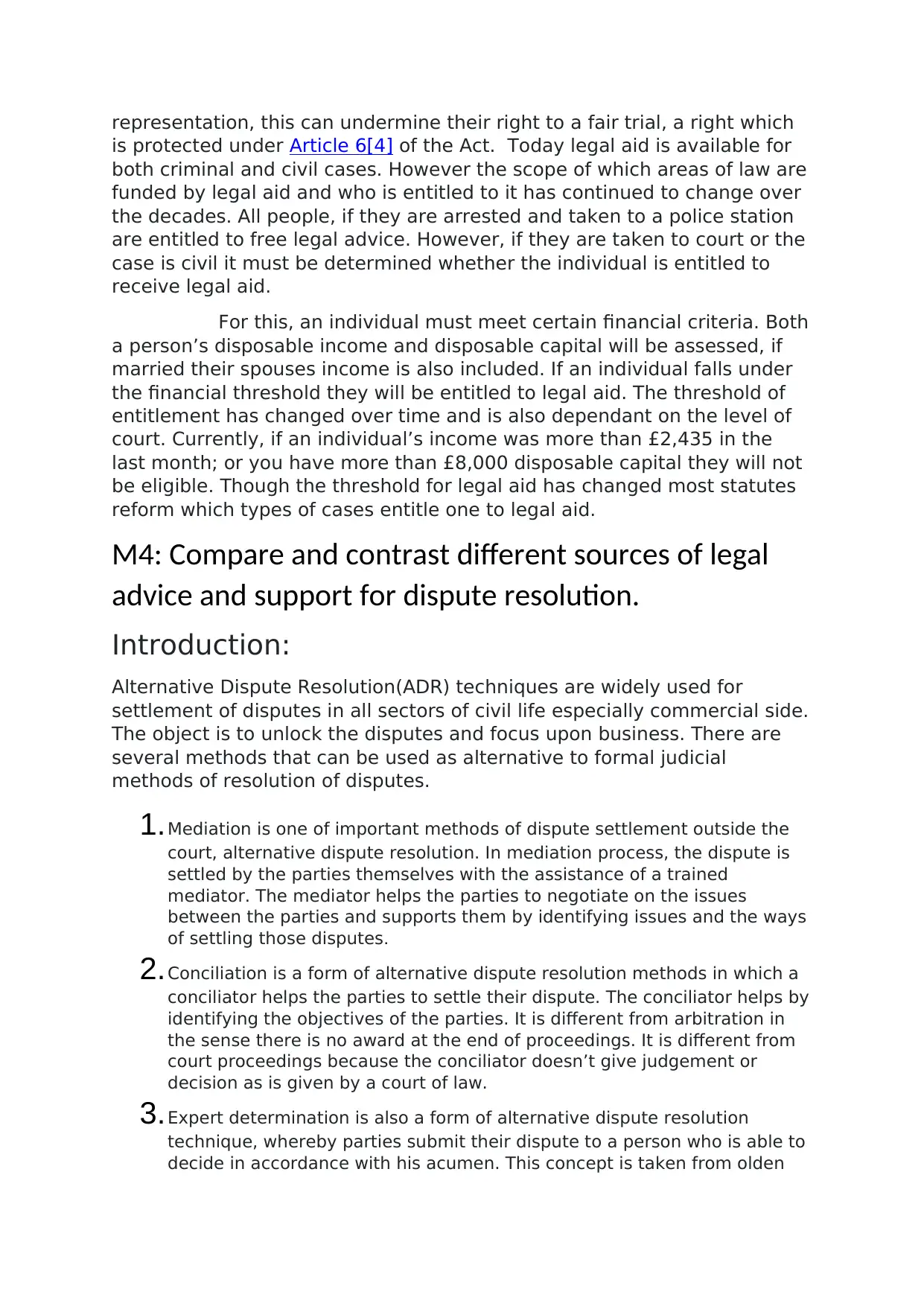
representation, this can undermine their right to a fair trial, a right which
is protected under Article 6[4] of the Act. Today legal aid is available for
both criminal and civil cases. However the scope of which areas of law are
funded by legal aid and who is entitled to it has continued to change over
the decades. All people, if they are arrested and taken to a police station
are entitled to free legal advice. However, if they are taken to court or the
case is civil it must be determined whether the individual is entitled to
receive legal aid.
For this, an individual must meet certain financial criteria. Both
a person’s disposable income and disposable capital will be assessed, if
married their spouses income is also included. If an individual falls under
the financial threshold they will be entitled to legal aid. The threshold of
entitlement has changed over time and is also dependant on the level of
court. Currently, if an individual’s income was more than £2,435 in the
last month; or you have more than £8,000 disposable capital they will not
be eligible. Though the threshold for legal aid has changed most statutes
reform which types of cases entitle one to legal aid.
M4: Compare and contrast different sources of legal
advice and support for dispute resolution.
Introduction:
Alternative Dispute Resolution(ADR) techniques are widely used for
settlement of disputes in all sectors of civil life especially commercial side.
The object is to unlock the disputes and focus upon business. There are
several methods that can be used as alternative to formal judicial
methods of resolution of disputes.
1.Mediation is one of important methods of dispute settlement outside the
court, alternative dispute resolution. In mediation process, the dispute is
settled by the parties themselves with the assistance of a trained
mediator. The mediator helps the parties to negotiate on the issues
between the parties and supports them by identifying issues and the ways
of settling those disputes.
2.Conciliation is a form of alternative dispute resolution methods in which a
conciliator helps the parties to settle their dispute. The conciliator helps by
identifying the objectives of the parties. It is different from arbitration in
the sense there is no award at the end of proceedings. It is different from
court proceedings because the conciliator doesn’t give judgement or
decision as is given by a court of law.
3.Expert determination is also a form of alternative dispute resolution
technique, whereby parties submit their dispute to a person who is able to
decide in accordance with his acumen. This concept is taken from olden
is protected under Article 6[4] of the Act. Today legal aid is available for
both criminal and civil cases. However the scope of which areas of law are
funded by legal aid and who is entitled to it has continued to change over
the decades. All people, if they are arrested and taken to a police station
are entitled to free legal advice. However, if they are taken to court or the
case is civil it must be determined whether the individual is entitled to
receive legal aid.
For this, an individual must meet certain financial criteria. Both
a person’s disposable income and disposable capital will be assessed, if
married their spouses income is also included. If an individual falls under
the financial threshold they will be entitled to legal aid. The threshold of
entitlement has changed over time and is also dependant on the level of
court. Currently, if an individual’s income was more than £2,435 in the
last month; or you have more than £8,000 disposable capital they will not
be eligible. Though the threshold for legal aid has changed most statutes
reform which types of cases entitle one to legal aid.
M4: Compare and contrast different sources of legal
advice and support for dispute resolution.
Introduction:
Alternative Dispute Resolution(ADR) techniques are widely used for
settlement of disputes in all sectors of civil life especially commercial side.
The object is to unlock the disputes and focus upon business. There are
several methods that can be used as alternative to formal judicial
methods of resolution of disputes.
1.Mediation is one of important methods of dispute settlement outside the
court, alternative dispute resolution. In mediation process, the dispute is
settled by the parties themselves with the assistance of a trained
mediator. The mediator helps the parties to negotiate on the issues
between the parties and supports them by identifying issues and the ways
of settling those disputes.
2.Conciliation is a form of alternative dispute resolution methods in which a
conciliator helps the parties to settle their dispute. The conciliator helps by
identifying the objectives of the parties. It is different from arbitration in
the sense there is no award at the end of proceedings. It is different from
court proceedings because the conciliator doesn’t give judgement or
decision as is given by a court of law.
3.Expert determination is also a form of alternative dispute resolution
technique, whereby parties submit their dispute to a person who is able to
decide in accordance with his acumen. This concept is taken from olden
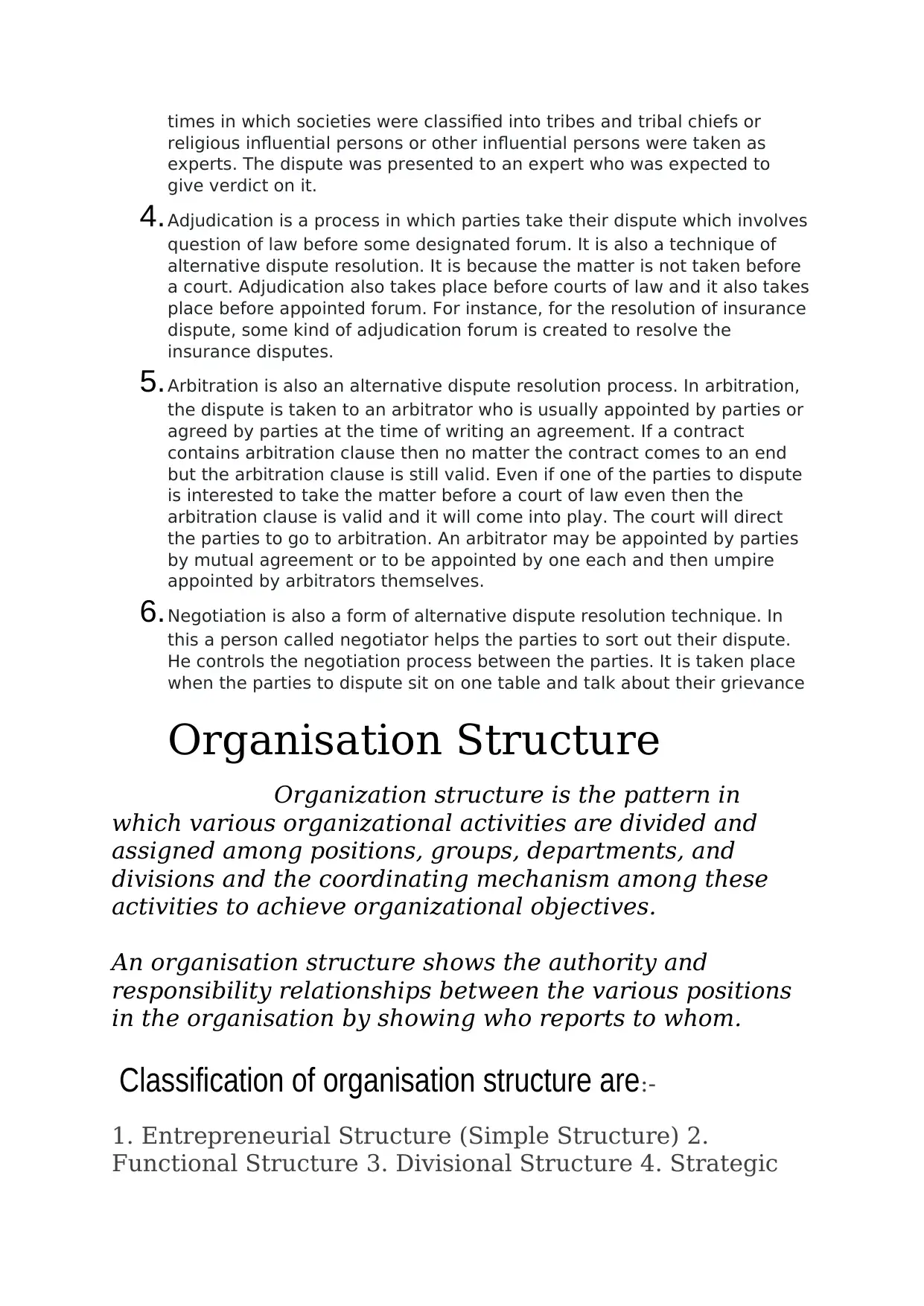
times in which societies were classified into tribes and tribal chiefs or
religious influential persons or other influential persons were taken as
experts. The dispute was presented to an expert who was expected to
give verdict on it.
4.Adjudication is a process in which parties take their dispute which involves
question of law before some designated forum. It is also a technique of
alternative dispute resolution. It is because the matter is not taken before
a court. Adjudication also takes place before courts of law and it also takes
place before appointed forum. For instance, for the resolution of insurance
dispute, some kind of adjudication forum is created to resolve the
insurance disputes.
5.Arbitration is also an alternative dispute resolution process. In arbitration,
the dispute is taken to an arbitrator who is usually appointed by parties or
agreed by parties at the time of writing an agreement. If a contract
contains arbitration clause then no matter the contract comes to an end
but the arbitration clause is still valid. Even if one of the parties to dispute
is interested to take the matter before a court of law even then the
arbitration clause is valid and it will come into play. The court will direct
the parties to go to arbitration. An arbitrator may be appointed by parties
by mutual agreement or to be appointed by one each and then umpire
appointed by arbitrators themselves.
6.Negotiation is also a form of alternative dispute resolution technique. In
this a person called negotiator helps the parties to sort out their dispute.
He controls the negotiation process between the parties. It is taken place
when the parties to dispute sit on one table and talk about their grievance
Organisation Structure
Organization structure is the pattern in
which various organizational activities are divided and
assigned among positions, groups, departments, and
divisions and the coordinating mechanism among these
activities to achieve organizational objectives.
An organisation structure shows the authority and
responsibility relationships between the various positions
in the organisation by showing who reports to whom.
Classification of organisation structure are:-
1. Entrepreneurial Structure (Simple Structure) 2.
Functional Structure 3. Divisional Structure 4. Strategic
religious influential persons or other influential persons were taken as
experts. The dispute was presented to an expert who was expected to
give verdict on it.
4.Adjudication is a process in which parties take their dispute which involves
question of law before some designated forum. It is also a technique of
alternative dispute resolution. It is because the matter is not taken before
a court. Adjudication also takes place before courts of law and it also takes
place before appointed forum. For instance, for the resolution of insurance
dispute, some kind of adjudication forum is created to resolve the
insurance disputes.
5.Arbitration is also an alternative dispute resolution process. In arbitration,
the dispute is taken to an arbitrator who is usually appointed by parties or
agreed by parties at the time of writing an agreement. If a contract
contains arbitration clause then no matter the contract comes to an end
but the arbitration clause is still valid. Even if one of the parties to dispute
is interested to take the matter before a court of law even then the
arbitration clause is valid and it will come into play. The court will direct
the parties to go to arbitration. An arbitrator may be appointed by parties
by mutual agreement or to be appointed by one each and then umpire
appointed by arbitrators themselves.
6.Negotiation is also a form of alternative dispute resolution technique. In
this a person called negotiator helps the parties to sort out their dispute.
He controls the negotiation process between the parties. It is taken place
when the parties to dispute sit on one table and talk about their grievance
Organisation Structure
Organization structure is the pattern in
which various organizational activities are divided and
assigned among positions, groups, departments, and
divisions and the coordinating mechanism among these
activities to achieve organizational objectives.
An organisation structure shows the authority and
responsibility relationships between the various positions
in the organisation by showing who reports to whom.
Classification of organisation structure are:-
1. Entrepreneurial Structure (Simple Structure) 2.
Functional Structure 3. Divisional Structure 4. Strategic
⊘ This is a preview!⊘
Do you want full access?
Subscribe today to unlock all pages.

Trusted by 1+ million students worldwide
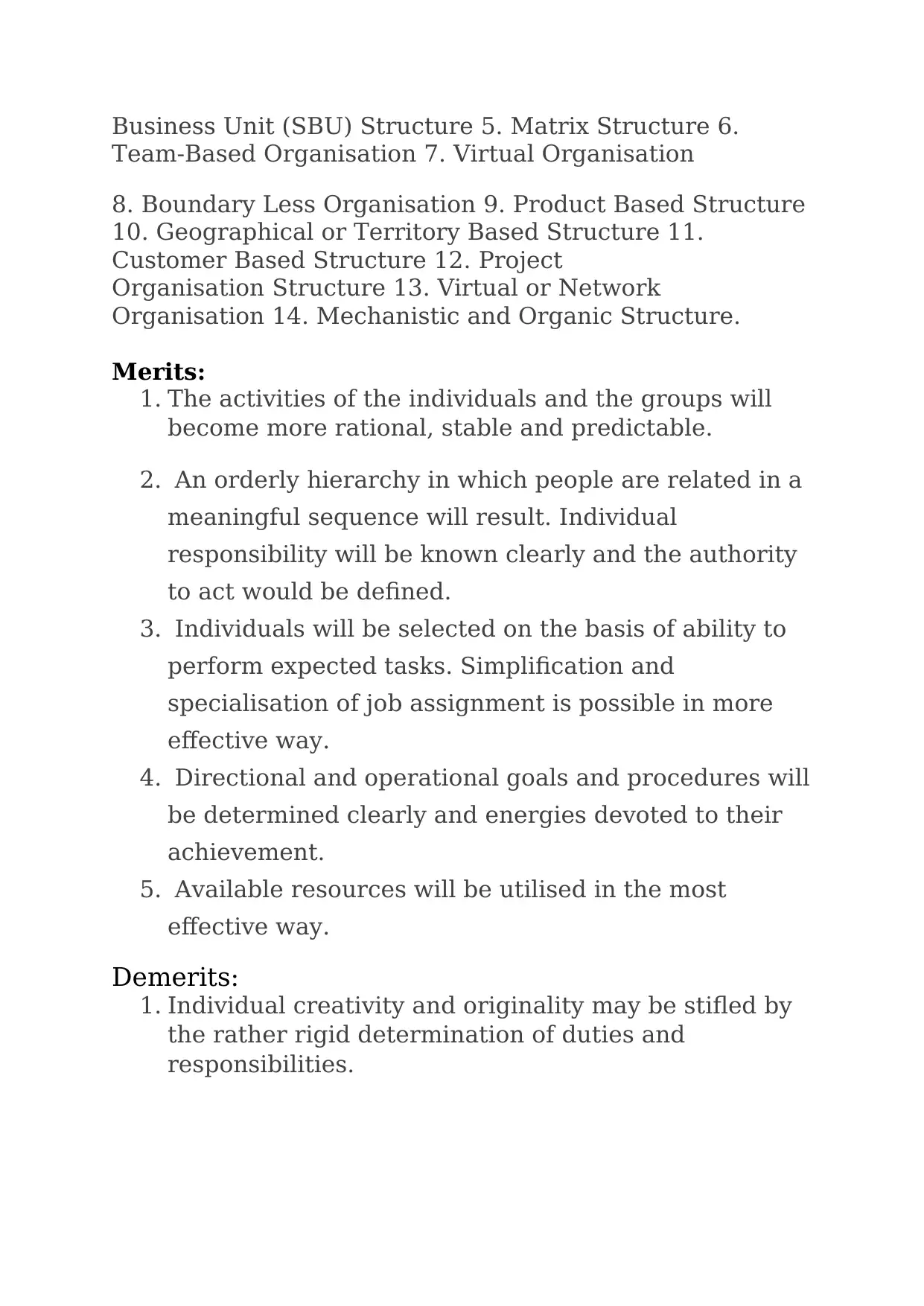
Business Unit (SBU) Structure 5. Matrix Structure 6.
Team-Based Organisation 7. Virtual Organisation
8. Boundary Less Organisation 9. Product Based Structure
10. Geographical or Territory Based Structure 11.
Customer Based Structure 12. Project
Organisation Structure 13. Virtual or Network
Organisation 14. Mechanistic and Organic Structure.
Merits:
1. The activities of the individuals and the groups will
become more rational, stable and predictable.
2. An orderly hierarchy in which people are related in a
meaningful sequence will result. Individual
responsibility will be known clearly and the authority
to act would be defined.
3. Individuals will be selected on the basis of ability to
perform expected tasks. Simplification and
specialisation of job assignment is possible in more
effective way.
4. Directional and operational goals and procedures will
be determined clearly and energies devoted to their
achievement.
5. Available resources will be utilised in the most
effective way.
Demerits:
1. Individual creativity and originality may be stifled by
the rather rigid determination of duties and
responsibilities.
Team-Based Organisation 7. Virtual Organisation
8. Boundary Less Organisation 9. Product Based Structure
10. Geographical or Territory Based Structure 11.
Customer Based Structure 12. Project
Organisation Structure 13. Virtual or Network
Organisation 14. Mechanistic and Organic Structure.
Merits:
1. The activities of the individuals and the groups will
become more rational, stable and predictable.
2. An orderly hierarchy in which people are related in a
meaningful sequence will result. Individual
responsibility will be known clearly and the authority
to act would be defined.
3. Individuals will be selected on the basis of ability to
perform expected tasks. Simplification and
specialisation of job assignment is possible in more
effective way.
4. Directional and operational goals and procedures will
be determined clearly and energies devoted to their
achievement.
5. Available resources will be utilised in the most
effective way.
Demerits:
1. Individual creativity and originality may be stifled by
the rather rigid determination of duties and
responsibilities.
Paraphrase This Document
Need a fresh take? Get an instant paraphrase of this document with our AI Paraphraser
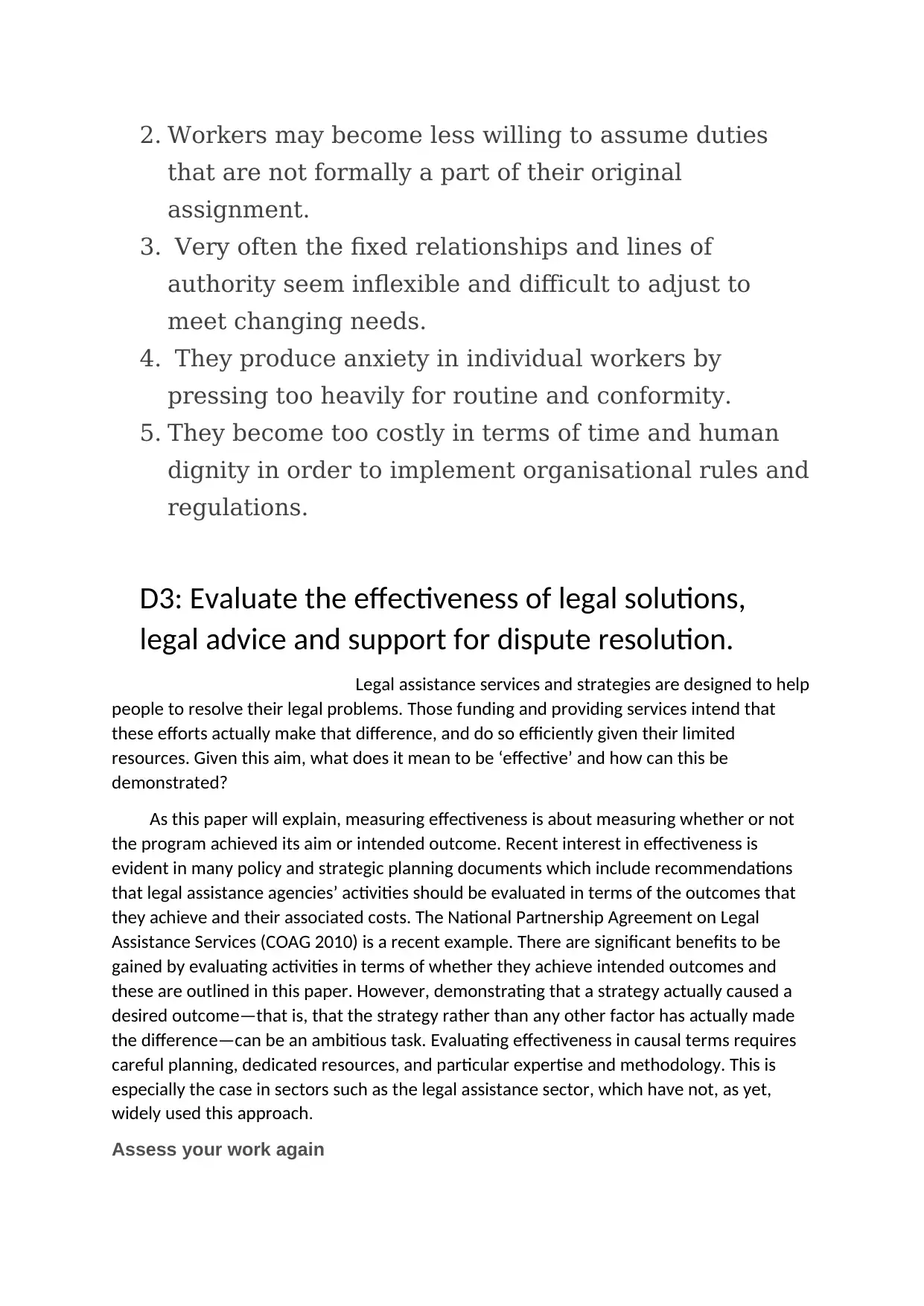
2. Workers may become less willing to assume duties
that are not formally a part of their original
assignment.
3. Very often the fixed relationships and lines of
authority seem inflexible and difficult to adjust to
meet changing needs.
4. They produce anxiety in individual workers by
pressing too heavily for routine and conformity.
5. They become too costly in terms of time and human
dignity in order to implement organisational rules and
regulations.
D3: Evaluate the effectiveness of legal solutions,
legal advice and support for dispute resolution.
Legal assistance services and strategies are designed to help
people to resolve their legal problems. Those funding and providing services intend that
these efforts actually make that difference, and do so efficiently given their limited
resources. Given this aim, what does it mean to be ‘effective’ and how can this be
demonstrated?
As this paper will explain, measuring effectiveness is about measuring whether or not
the program achieved its aim or intended outcome. Recent interest in effectiveness is
evident in many policy and strategic planning documents which include recommendations
that legal assistance agencies’ activities should be evaluated in terms of the outcomes that
they achieve and their associated costs. The National Partnership Agreement on Legal
Assistance Services (COAG 2010) is a recent example. There are significant benefits to be
gained by evaluating activities in terms of whether they achieve intended outcomes and
these are outlined in this paper. However, demonstrating that a strategy actually caused a
desired outcome—that is, that the strategy rather than any other factor has actually made
the difference—can be an ambitious task. Evaluating effectiveness in causal terms requires
careful planning, dedicated resources, and particular expertise and methodology. This is
especially the case in sectors such as the legal assistance sector, which have not, as yet,
widely used this approach.
Assess your work again
that are not formally a part of their original
assignment.
3. Very often the fixed relationships and lines of
authority seem inflexible and difficult to adjust to
meet changing needs.
4. They produce anxiety in individual workers by
pressing too heavily for routine and conformity.
5. They become too costly in terms of time and human
dignity in order to implement organisational rules and
regulations.
D3: Evaluate the effectiveness of legal solutions,
legal advice and support for dispute resolution.
Legal assistance services and strategies are designed to help
people to resolve their legal problems. Those funding and providing services intend that
these efforts actually make that difference, and do so efficiently given their limited
resources. Given this aim, what does it mean to be ‘effective’ and how can this be
demonstrated?
As this paper will explain, measuring effectiveness is about measuring whether or not
the program achieved its aim or intended outcome. Recent interest in effectiveness is
evident in many policy and strategic planning documents which include recommendations
that legal assistance agencies’ activities should be evaluated in terms of the outcomes that
they achieve and their associated costs. The National Partnership Agreement on Legal
Assistance Services (COAG 2010) is a recent example. There are significant benefits to be
gained by evaluating activities in terms of whether they achieve intended outcomes and
these are outlined in this paper. However, demonstrating that a strategy actually caused a
desired outcome—that is, that the strategy rather than any other factor has actually made
the difference—can be an ambitious task. Evaluating effectiveness in causal terms requires
careful planning, dedicated resources, and particular expertise and methodology. This is
especially the case in sectors such as the legal assistance sector, which have not, as yet,
widely used this approach.
Assess your work again
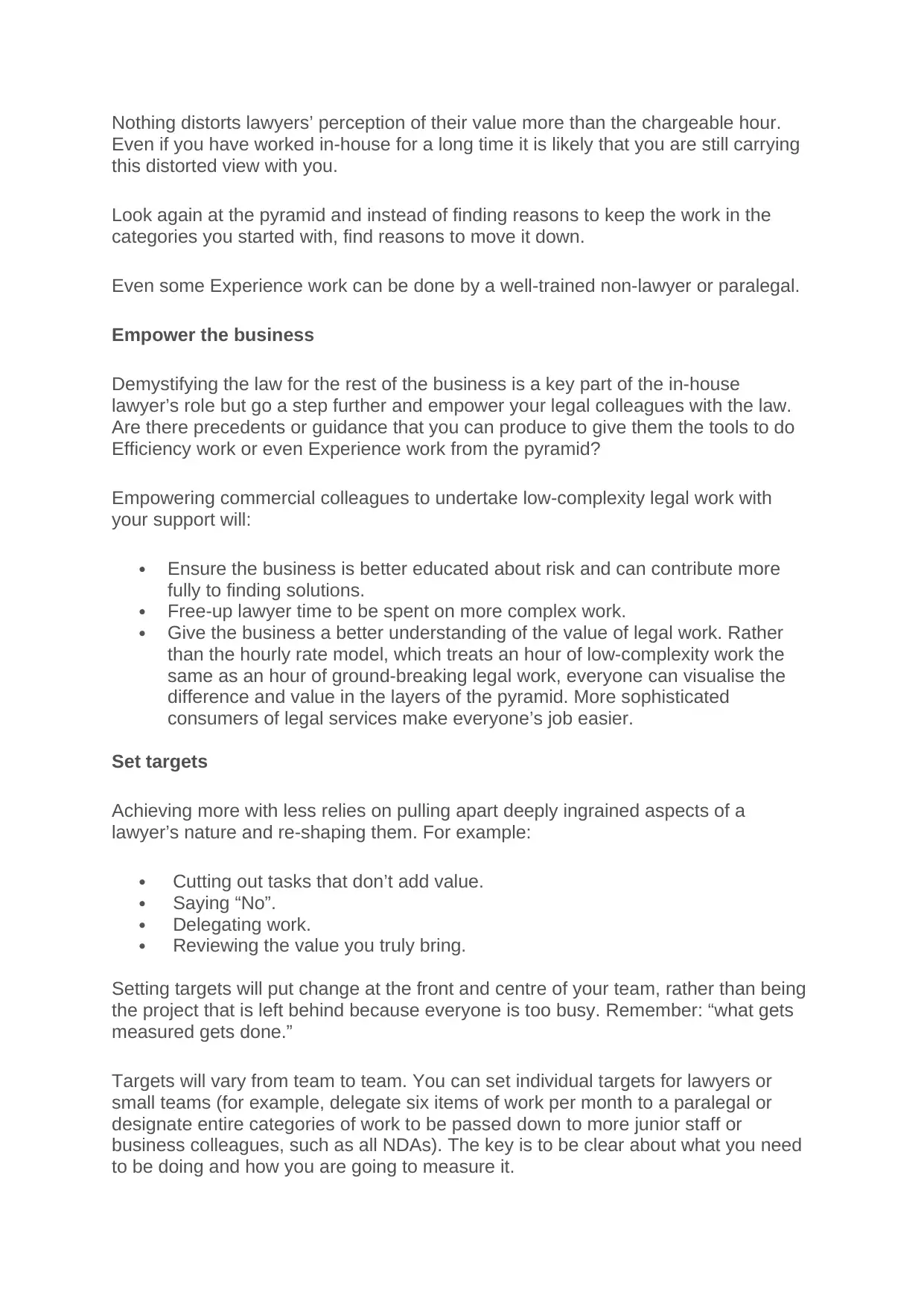
Nothing distorts lawyers’ perception of their value more than the chargeable hour.
Even if you have worked in-house for a long time it is likely that you are still carrying
this distorted view with you.
Look again at the pyramid and instead of finding reasons to keep the work in the
categories you started with, find reasons to move it down.
Even some Experience work can be done by a well-trained non-lawyer or paralegal.
Empower the business
Demystifying the law for the rest of the business is a key part of the in-house
lawyer’s role but go a step further and empower your legal colleagues with the law.
Are there precedents or guidance that you can produce to give them the tools to do
Efficiency work or even Experience work from the pyramid?
Empowering commercial colleagues to undertake low-complexity legal work with
your support will:
Ensure the business is better educated about risk and can contribute more
fully to finding solutions.
Free-up lawyer time to be spent on more complex work.
Give the business a better understanding of the value of legal work. Rather
than the hourly rate model, which treats an hour of low-complexity work the
same as an hour of ground-breaking legal work, everyone can visualise the
difference and value in the layers of the pyramid. More sophisticated
consumers of legal services make everyone’s job easier.
Set targets
Achieving more with less relies on pulling apart deeply ingrained aspects of a
lawyer’s nature and re-shaping them. For example:
Cutting out tasks that don’t add value.
Saying “No”.
Delegating work.
Reviewing the value you truly bring.
Setting targets will put change at the front and centre of your team, rather than being
the project that is left behind because everyone is too busy. Remember: “what gets
measured gets done.”
Targets will vary from team to team. You can set individual targets for lawyers or
small teams (for example, delegate six items of work per month to a paralegal or
designate entire categories of work to be passed down to more junior staff or
business colleagues, such as all NDAs). The key is to be clear about what you need
to be doing and how you are going to measure it.
Even if you have worked in-house for a long time it is likely that you are still carrying
this distorted view with you.
Look again at the pyramid and instead of finding reasons to keep the work in the
categories you started with, find reasons to move it down.
Even some Experience work can be done by a well-trained non-lawyer or paralegal.
Empower the business
Demystifying the law for the rest of the business is a key part of the in-house
lawyer’s role but go a step further and empower your legal colleagues with the law.
Are there precedents or guidance that you can produce to give them the tools to do
Efficiency work or even Experience work from the pyramid?
Empowering commercial colleagues to undertake low-complexity legal work with
your support will:
Ensure the business is better educated about risk and can contribute more
fully to finding solutions.
Free-up lawyer time to be spent on more complex work.
Give the business a better understanding of the value of legal work. Rather
than the hourly rate model, which treats an hour of low-complexity work the
same as an hour of ground-breaking legal work, everyone can visualise the
difference and value in the layers of the pyramid. More sophisticated
consumers of legal services make everyone’s job easier.
Set targets
Achieving more with less relies on pulling apart deeply ingrained aspects of a
lawyer’s nature and re-shaping them. For example:
Cutting out tasks that don’t add value.
Saying “No”.
Delegating work.
Reviewing the value you truly bring.
Setting targets will put change at the front and centre of your team, rather than being
the project that is left behind because everyone is too busy. Remember: “what gets
measured gets done.”
Targets will vary from team to team. You can set individual targets for lawyers or
small teams (for example, delegate six items of work per month to a paralegal or
designate entire categories of work to be passed down to more junior staff or
business colleagues, such as all NDAs). The key is to be clear about what you need
to be doing and how you are going to measure it.
⊘ This is a preview!⊘
Do you want full access?
Subscribe today to unlock all pages.

Trusted by 1+ million students worldwide

For Reference :
www.lawteacher.com
www.njordlaw.com
www.slideshare.net
www.businessmanagerialideas.com
www.articlelibrary.com
www.lawteacher.com
www.njordlaw.com
www.slideshare.net
www.businessmanagerialideas.com
www.articlelibrary.com
1 out of 7
Related Documents
Your All-in-One AI-Powered Toolkit for Academic Success.
+13062052269
info@desklib.com
Available 24*7 on WhatsApp / Email
![[object Object]](/_next/static/media/star-bottom.7253800d.svg)
Unlock your academic potential
Copyright © 2020–2025 A2Z Services. All Rights Reserved. Developed and managed by ZUCOL.





